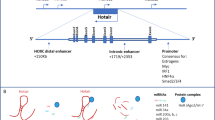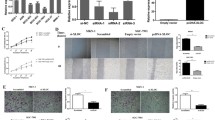Abstract
Long non-coding RNAs (lncRNAs) are widely involved in a variety of biological processes, including epithelial-mesenchymal transition (EMT). In the current study, we found that lncRNA small nucleolar RNA host gene 8 (SNHG8) was tightly correlated with EMT-associated gene signatures, and was down-regulated by Zinc finger E-box-binding homeobox 1 (ZEB1) during EMT progress. Functionally, knockdown of SNHG8 induced EMT in epithelial cells, through destabilizing the CDH1 mRNA dependent on a 17-nucleotide sequence shared by SNHG8 and CDH1. In addition, analysis with public database showed that SNHG8 tended to be down-regulated in different cancer types and the lower expression of SNHG8 predicted poorer prognosis. Taken together, our study reports a ZEB1-repressed lncRNA SNHG8 which is important for stabilizing CDH1 mRNA, thereby maintaining the epithelial status of epithelial cells.
Similar content being viewed by others
References
Aiello, N.M., and Kang, Y. (2019). Context-dependent EMT programs in cancer metastasis. J Exp Med 216, 1016–1026.
Cao, Q., Yu, J., Dhanasekaran, S.M., Kim, J.H., Mani, R.S., Tomlins, S.A., Mehra, R., Laxman, B., Cao, X., Yu, J., et al. (2008). Repression of E-cadherin by the polycomb group protein EZH2 in cancer. Oncogene 27, 7274–7284.
Chen, C., Zhang, Z., Li, J., and Sun, Y. (2018). SNHG8 is identified as a key regulator in non-small-cell lung cancer progression sponging to miR-542-3p by targeting CCND1/CDK6. Onco Targets Ther 11, 6081–6090.
Chen, Y., Qiu, F., Huang, L., Liu, W., Li, L., Ji, C., Zeng, X., Qiao, L., Liu, M., and Gong, X. (2020). Long non-coding RNA LINC00312 regulates breast cancer progression through the miR-9/CDH1 axis. Mol Med Report 21, 1296–1303.
Cheng, L., Yang, T., Kuang, Y., Kong, B., Yu, S., Shu, H., Zhou, H., and Gu, J. (2014). MicroRNA-23a promotes neuroblastoma cell metastasis by targeting CDH1. Oncol Lett 7, 839–845.
Dai, X., Xin, Y., Xu, W., Tian, X., Wei, X., and Zhang, H. (2020). CBP-mediated Slug acetylation stabilizes Slug and promotes EMT and migration of breast cancer cells. Sci China Life Sci doi: https://doi.org/10.1007/s11427-020-1736-5.
Daly, C.S., Flemban, A., Shafei, M., Conway, M.E., Qualtrough, D., and Dean, S.J. (2018). Hypoxia modulates the stem cell population and induces EMT in the MCF-10A breast epithelial cell line. Oncol Rep 39, 483–490.
Dhamija, S., and Diederichs, S. (2016). From junk to master regulators of invasion: lncRNA functions in migration, EMT and metastasis. Int J Cancer 139, 269–280.
Dong, J., Teng, F., Guo, W., Yang, J., Ding, G., and Fu, Z. (2018). lncRNA SNHG8 promotes the tumorigenesis and metastasis by sponging miR-149-5p and predicts tumor recurrence in hepatocellular carcinoma. Cell Physiol Biochem 51, 2262–2274.
Fujita, Y., Krause, G., Scheffner, M., Zechner, D., Leddy, H.E.M., Behrens, J., Sommer, T., and Birchmeier, W. (2002). Hakai, a c-Cbl-like protein, ubiquitinates and induces endocytosis of the E-cadherin complex. Nat Cell Biol 4, 222–231.
Gao, L.M., Xu, S.F., Zheng, Y., Wang, P., Zhang, L., Shi, S.S., Wu, T., Li, Y., Zhao, J., Tian, Q., et al. (2019). Long non-coding RNA H19 is responsible for the progression of lung adenocarcinoma by mediating methylation-dependent repression of CDH1 promoter. J Cell Mol Med 23, 6411–6428.
Geissler, R., and Grimson, A. (2016). A position-specific 3′UTR sequence that accelerates mRNA decay. RNA Biol 13, 1075–1077.
Hogg, J.R., and Goff, S.P. (2010). Upf1 senses 3’UTR length to potentiate mRNA decay. Cell 143, 379–389.
Ivanov, A.I., Nusrat, A., and Parkos, C.A. (2004). Endocytosis of epithelial apical junctional proteins by a clathrin-mediated pathway into a unique storage compartment. Mol Biol Cell 15, 176–188.
Jeanes, A., Gottardi, C.J., and Yap, A.S. (2008). Cadherins and cancer: how does cadherin dysfunction promote tumor progression? Oncogene 27, 6920–6929.
Lavin, D.P., and Tiwari, V.K. (2020). Unresolved complexity in the gene regulatory network underlying EMT. Front Oncol 10, 554.
Li, L., and Li, W. (2015). Epithelial-mesenchymal transition in human cancer: Comprehensive reprogramming of metabolism, epigenetics, and differentiation. Pharmacol Ther 150, 33–46.
Ma, L., Young, J., Prabhala, H., Pan, E., Mestdagh, P., Muth, D., Teruya-Feldstein, J., Reinhardt, F., Onder, T.T., Valastyan, S., et al. (2010). miR-9, a MYC/MYCN-activated microRNA, regulates E-cadherin and cancer metastasis. Nat Cell Biol 12, 247–256.
Madany, M., Thomas, T., and Edwards, L.A. (2018). The curious case of ZEB1. Discoveries 6, e86.
Magnani, E., Macchi, F., Mancini, M., Lomazzi, V., Cogliati, S., Pistore, C., Mandruzzato, M., Dock-Bregeon, A.C., and Bonapace, I.M. (2018). UHRF1 regulates CDH1 via promoter associated non-coding RNAs in prostate cancer cells. Biochim Biophys Acta 1861, 258–270.
Matoulkova, E., Michalova, E., Vojtesek, B., and Hrstka, R. (2012). The role of the 3′ untranslated region in post-transcriptional regulation of protein expression in mammalian cells. RNA Biol 9, 563–576.
Mayr, C. (2016). Evolution and biological roles of alternative 3′UTRs. Trends Cell Biol 26, 227–237.
Mayr, C. (2017). Regulation by 3′-untranslated regions. Annu Rev Genet 51, 171–194.
Okayama, H., Kohno, T., Ishii, Y., Shimada, Y., Shiraishi, K., Iwakawa, R., Furuta, K., Tsuta, K., Shibata, T., Yamamoto, S., et al. (2012). Identification of genes upregulated in ALK-positive and EGFR/KRAS/ALK-negative lung adenocarcinomas. Cancer Res 72, 100–111.
Pal, M., Bhattacharya, S., Kalyan, G., and Hazra, S. (2018). Cadherin profiling for therapeutic interventions in epithelial mesenchymal transition (EMT) and tumorigenesis. Exp Cell Res 368, 137–146.
Partridge, E.C., Chhetri, S.B., Prokop, J.W., Ramaker, R.C., Jansen, C.S., Goh, S.T., Mackiewicz, M., Newberry, K.M., Brandsmeier, L.A., Meadows, S.K., et al. (2020). Occupancy maps of 208 chromatin-associated proteins in one human cell type. Nature 583, 720–728.
Peinado, H., Portillo, F., and Cano, A. (2004). Transcriptional regulation of cadherins during development and carcinogenesis. Int J Dev Biol 48, 365–375.
Pisignano, G., Napoli, S., Magistri, M., Mapelli, S.N., Pastori, C., Di Marco, S., Civenni, G., Albino, D., Enriquez, C., Allegrini, S., et al. (2017). A promoter-proximal transcript targeted by genetic polymorphism controls E-cadherin silencing in human cancers. Nat Commun 8, 15622.
Puisieux, A., Brabletz, T., and Caramel, J. (2014). Oncogenic roles of EMT-inducing transcription factors. Nat Cell Biol 16, 488–494.
Qi, X., Zhang, D.H., Wu, N., Xiao, J.H., Wang, X., and Ma, W. (2015). ceRNA in cancer: possible functions and clinical implications. J Med Genet 52, 710–718.
Sarrió, D., Moreno-Bueno, G., Hardisson, D., Sánchez-Estévez, C., Guo, M., Herman, J.G., Gamallo, C., Esteller, M., and Palacios, J. (2003). Epigenetic and genetic alterations of APC and CDH1 genes in lobular breast cancer: Relationships with abnormal E-cadherin and catenin expression and microsatellite instability. Int J Cancer 106, 208–215.
Shen, S.M., Guo, M., Xiong, Z., Yu, Y., Zhao, X.Y., Zhang, F.F., and Chen, G.Q. (2015). AIF inhibits tumor metastasis by protecting PTEN from oxidation. EMBO Rep 16, 1563–1580.
Song, Y., Zou, L., Li, J., Shen, Z.P., Cai, Y.L., and Wu, X.D. (2018). LncRNA SNHG8 promotes the development and chemo-resistance of pancreatic adenocarcinoma. Eur Rev Med Pharmacol Sci 22, 8161–8168.
Subramanian, A., Tamayo, P., Mootha, V.K., Mukherjee, S., Ebert, B.L., Gillette, M.A., Paulovich, A., Pomeroy, S.L., Golub, T.R., Lander, E.S., et al. (2005). Gene set enrichment analysis: a knowledge-based approach for interpreting genome-wide expression profiles. Proc Natl Acad Sci USA 102, 15545–15550.
Tam, S.Y., Wu, V.W.C., and Law, H.K.W. (2020). Hypoxia-induced epithelial-mesenchymal transition in cancers: HIF-1a and beyond. Front Oncol 10, 486.
Tan, E.J., Kahata, K., Idås, O., Thuault, S., Heldin, C.H., and Moustakas, A. (2015). The high mobility group A2 protein epigenetically silences the Cdh1 gene during epithelial-to-mesenchymal transition. Nucleic Acids Res 43, 162–178.
Tang, J., Zhan, M.N., Yin, Q.Q., Zhou, C.X., Wang, C.L., Wo, L.L., He, M., Chen, G.Q., and Zhao, Q. (2017). Impaired p65 degradation by decreased chaperone-mediated autophagy activity facilitates epithelialto-mesenchymal transition. Oncogenesis 6, e387.
Taube, J.H., Herschkowitz, J.I., Komurov, K., Zhou, A.Y., Gupta, S., Yang, J., Hartwell, K., Onder, T.T., Gupta, P.B., Evans, K.W., et al. (2010). Core epithelial-to-mesenchymal transition interactome gene-expression signature is associated with claudin-low and metaplastic breast cancer subtypes. Proc Natl Acad Sci USA 107, 15449–15454.
Tay, Y., Rinn, J., and Pandolfi, P.P. (2014). The multilayered complexity of ceRNA crosstalk and competition. Nature 505, 344–352.
Wang, J., Zhang, J., Xiong, Y., Li, J., Li, X., Zhao, J., Zhu, G., He, H., Mayinuer, Y., and Wan, X. (2020). TGF-β regulation of microRNA miR-497-5p and ocular lens epithelial cell mesenchymal transition. Sci China Life Sci 63, 1928–1937.
Yang, J.Y., Zong, C.S., Xia, W., Wei, Y., Ali-Seyed, M., Li, Z., Broglio, K., Berry, D.A., and Hung, M.C. (2006). MDM2 promotes cell motility and invasiveness by regulating E-cadherin degradation. Mol Cell Biol 26, 7269–7282.
Yoshihara, K., Tajima, A., Yahata, T., Kodama, S., Fujiwara, H., Suzuki, M., Onishi, Y., Hatae, M., Sueyoshi, K., Fujiwara, H., et al. (2010). Gene expression profile for predicting survival in advanced-stage serous ovarian cancer across two independent datasets. PLoS ONE 5, e9615.
Zhang, L., Sun, J., Wang, B., Ren, J.C., Su, W., and Zhang, T. (2015). MicroRNA-10b triggers the epithelial-mesenchymal transition (EMT) of laryngeal carcinoma Hep-2 cells by directly targeting the E-cadherin. Appl Biochem Biotechnol 176, 33–44.
Zhen, Y., Ye, Y., Wang, H., Xia, Z.S., Wang, B., Yi, W., and Deng, X. (2019). Knockdown of SNHG8 repressed the growth, migration, and invasion of colorectal cancer cells by directly sponging with miR-663. Biomed Pharmacother 116, 109000.
Zhou, B.P., Deng, J., Xia, W., Xu, J., Li, Y.M., Gunduz, M., and Hung, M. C. (2004). Dual regulation of Snail by GSK-3β-mediated phosphorylation in control of epithelial-mesenchymal transition. Nat Cell Biol 6, 931–940.
Zhu, W., Leber, B., and Andrews, D.W. (2001). Cytoplasmic O-glycosylation prevents cell surface transport of E-cadherin during apoptosis. EMBO J 20, 5999–6007.
Acknowledgements
This work was supported by the National Natural Science Foundation of China (82022053, 81830091, 91853206, and 81972583), the National Key Research and Development Program of China (2020YFA0803403), CAMS Innovation Fund for Medical Sciences (CIFMS) (2019-I2M-5-051) and the Fundamental Research Funds for the Central Universities.
Author information
Authors and Affiliations
Corresponding author
Additional information
Compliance and ethics
The author(s) declare that they have no conflict of interest.
Rights and permissions
About this article
Cite this article
He, P., Zhang, C., Chen, G. et al. Loss of lncRNA SNHG8 promotes epithelial-mesenchymal transition by destabilizing CDH1 mRNA. Sci. China Life Sci. 64, 1858–1867 (2021). https://doi.org/10.1007/s11427-020-1895-2
Received:
Accepted:
Published:
Issue Date:
DOI: https://doi.org/10.1007/s11427-020-1895-2




